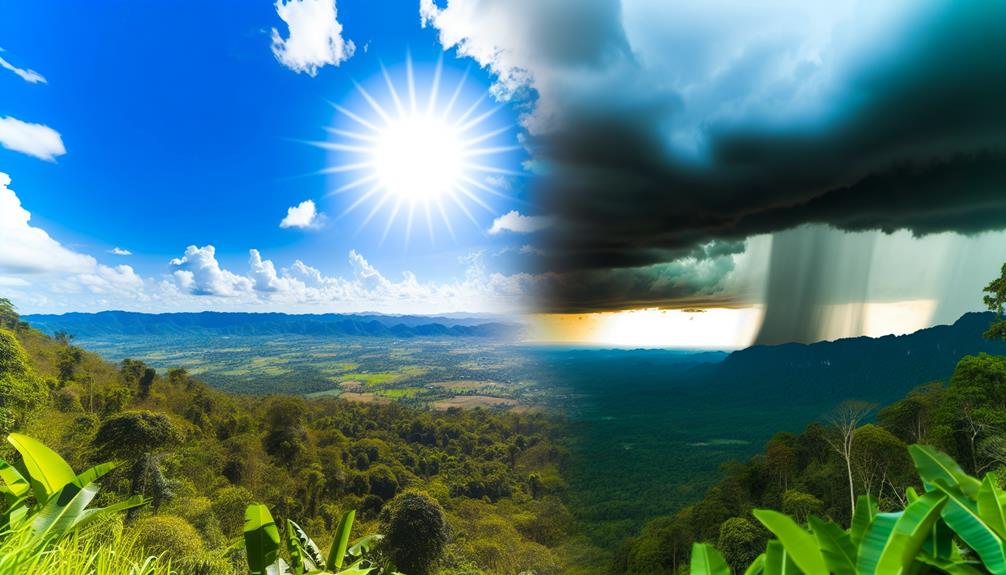As you bask in the sun, drench in the rain, or seek shelter from a storm, it's clear that Thailand's weather is as diverse as it is dynamic. The country's climatic shifts each month aren't just incidental—they're the result of a complex interplay between monsoon winds, geographical nuances, and global weather patterns.
While you may appreciate the warmth of Thailand's sunny spells or the relief brought by its rainy days, have you ever considered the intricate forces at work behind these monthly transformations? Unpacking the reasons behind Thailand's ever-changing skies not only satisfies curiosity but also reveals the delicate balance of our planet's ecosystem, a balance that affects everything from agriculture to your very own travel plans.
Stay with this discussion to uncover the threads that weave together to create Thailand's unique tapestry of weather.
The Monsoon Seasons

While Thailand's weather is generally warm and tropical, the monsoon seasons bring about a significant transformation in the country's climate. You'll notice the shift when the skies darken and the winds pick up, usually between May and October. This period, known as the Southwest Monsoon, drenches the country with heavy rainfall. It's nature's way of turning the landscape lush and green, but it also means you've got to be ready for sudden downpours.
Come November, the climate begins to change again as the Northeast Monsoon takes over. This season, lasting until February, sees cooler and drier air sweeping down from China, giving you a much-needed break from the relentless heat. It's the perfect time for you to explore the outdoors without the worry of rain interrupting your plans.
But don't let the monsoon seasons deter you. They're a part of what makes Thailand's weather so dynamic and interesting. Just pack a raincoat and embrace the rhythm of the tropics. And remember, when the rains come, they leave behind a refreshed and vibrant scenery that's truly breathtaking.
Regional Geographical Variance
Thailand's diverse topography means you'll experience different weather patterns depending on where you visit in the country. The mountainous north, with its lush highlands, often enjoys cooler temperatures, especially in the evenings. You might even need a jacket if you're venturing into the higher altitudes around Chiang Mai or Pai.
In contrast, the northeastern plateau, known as Isaan, can get quite hot, but it's less humid than other regions, offering a dry heat that some find more comfortable.
Heading south, you'll hit the central plains, the country's rice bowl, where the weather is generally hot and humid, typified by Bangkok's sticky heat. As you travel further towards the peninsula, you'll notice the humidity intensifying.
The coasts on either side of the peninsula, facing the Andaman Sea and the Gulf of Thailand, are subject to different monsoon cycles. You could be soaking up the sun on Koh Samui while the west coast is drenched by torrential rains.
Influence of Marine Proximity

As you explore Thailand's varied landscapes, the proximity to the sea significantly shapes the local climate you'll experience. Coastal areas, like those in the south and along the eastern seaboard, typically enjoy a maritime climate. This means you'll find milder temperatures and higher humidity levels. The sea acts as a vast heat reservoir, absorbing the sun's warmth during the day and releasing it slowly at night, which helps to moderate temperatures in nearby areas.
In contrast, if you venture inland, you'll notice the weather becomes more continental, with greater temperature extremes between day and night. Without the sea's moderating influence, the heat can become more intense, and nights might turn cooler.
Moreover, the marine influence also affects rainfall patterns. Monsoons, driven by the warm sea surface temperatures, bring heavy rains to coastal regions. As you travel during the rainy season, you'll see that areas closer to the sea often get drenched more frequently and with greater intensity than those further inland.
Understanding the influence of marine proximity on Thailand's weather is crucial when planning your visit. Whether you're basking on a beach or trekking through the hinterlands, you'll be better equipped to anticipate the local weather and pack accordingly.
Seasonal Temperature Fluctuations
Seasonal shifts bring a dramatic change to Thailand's temperatures, with the scorching heat of summer giving way to cooler breezes in the winter months. You'll notice this variation distinctly as you move through the year.
During April and May, temperatures can soar above 35°C, making these months the hottest time to visit. If you're not a fan of intense heat, you'd want to avoid this period.
Come June, you'll start to feel the onset of the rainy season, which cools things down slightly, but the humidity kicks up a notch. Don't let the rain fool you, though; it's still pretty warm, with daytime temperatures hovering around 30°C. It's the kind of weather that makes you crave a tropical smoothie or a dip in the sea.
Global Climatic Patterns

While Thailand experiences its own unique weather patterns, it's important to consider how these fit into the broader tapestry of global climatic trends. You're living in a world where weather is a complex puzzle, influenced by a myriad of factors that stretch far beyond your local horizon. The planet's climate system is interconnected, so what happens in the Arctic doesn't stay in the Arctic—it can affect weather in the tropics.
You've probably heard about El Niño and La Niña, part of a larger phenomenon known as the El Niño-Southern Oscillation (ENSO). These events can disrupt weather patterns globally, often leading to wetter or drier conditions in different parts of the world, including Thailand. When El Niño takes the stage, you might see reduced rainfall in Southeast Asia, while La Niña could bring more of it.
Additionally, you're affected by the Indian Ocean Dipole, another climatic factor that particularly influences the monsoon season. Depending on the year, it can either enhance or diminish the monsoon rains that you expect.
Understanding these global climatic patterns helps you grasp why some months in Thailand are uncharacteristically dry or wet, and why forecasting weather isn't just local guesswork. It's a global science that considers everything from ocean temperatures to wind patterns across the planet.
Frequently Asked Questions
How Does the Urban Heat Island Effect Alter Weather Patterns in Major Thai Cities Compared to Rural Areas?
In major Thai cities, the urban heat island effect raises temperatures compared to rural areas, altering local weather patterns by often intensifying the heat and affecting rainfall distribution.
What Is the Role of Deforestation in Thailand in Shaping Local Weather Changes Each Month?
Deforestation in Thailand affects local weather by altering rainfall and temperature patterns, potentially leading to more extreme monthly changes that you might experience.
How Do Traditional Thai Agricultural Practices Adapt to the Monthly Changes in Weather?
You adapt traditional Thai farming techniques monthly, utilizing rain-fed paddy fields during monsoons and diversifying crops to suit dry spells, ensuring sustainable agriculture in Thailand's varying climate.
Are There Any Indigenous Weather Forecasting Methods in Thailand That Differ From Modern Meteorological Techniques?
You'll find that Thailand has unique indigenous forecasting methods, such as observing animal behavior and plant growth, which differ significantly from modern meteorological techniques.
How Does Air Pollution From Neighboring Countries Affect Thailand's Monthly Weather Patterns?
Air pollution from nearby countries can worsen your local air quality in Thailand and influence weather patterns, potentially leading to more haze and affecting rainfall and temperature variability each month.
Conclusion
You've seen how Thailand's weather dances to the tune of monsoons, shaped by its geography and seas. The land's warmth ebbs and flows with the seasons, while global climate patterns play their part.
So, as you pack your bags, remember, whether it's the lush rains or the cool breeze, each month brings its own slice of Thai weather. Embrace the change; it's all part of the adventure in this vibrant, ever-changing landscape.




